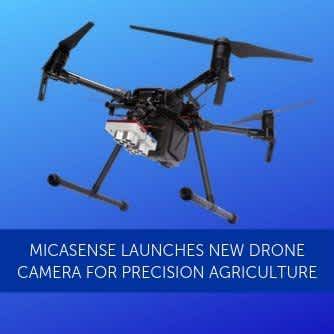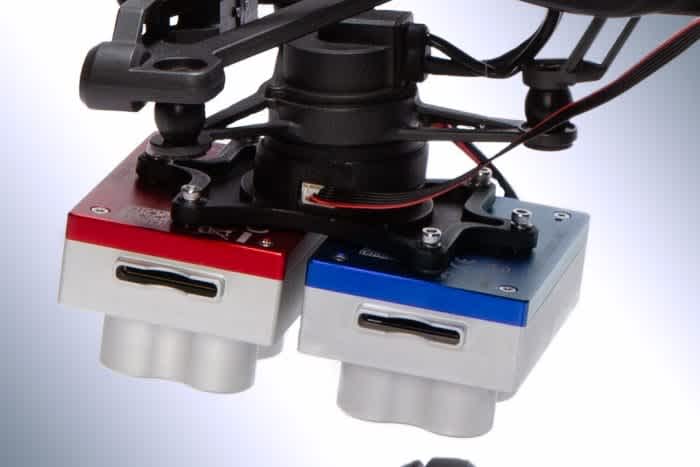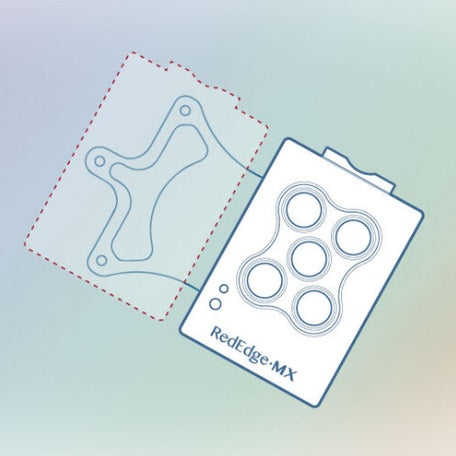
Updated on • 17 Sep 2024
MicaSense Launches New Drone Camera For Precision Agriculture
Heliguy's strategic partner MicaSense has released the RedEdge-MX Dual Camera Imaging System - a synchronised 10 band solution for advanced remote sensing and agricultural research. ... Read More

Heliguy's strategic partner MicaSense has released the RedEdge-MX Dual Camera Imaging System - a synchronised 10 band solution for advanced remote sensing and agricultural research.
Featuring the new RedEdge-MX Blue, this solution captures the standard bands of MicaSense's existing RedEdge-MX sensor, plus a new group of filters to enable more analysis like shallow water environments monitoring or detailed analysis on chlorophyll efficiency.

The MicaSense RedEdge-MX Dual Camera Imaging System integrated with a DJI M200 Series drone.
Compatible with DJI drones and industry-standard software platforms, such as Pix4D and Agisoft, this 10 band solution ensures that flying with two cameras is just as easy as flying with one.
Drones and their sophisticated payloads have revolutionised agriculture and MicaSense’s cameras help to improve crop management, enhance workflows, drive key decision-making and maximise results.
To purchase a RedEdge-MX Dual Camera Imaging System, inquire with Heliguy now.
Key Features of the MicaSense RedEdge-MX Dual Camera Imaging System
The MicaSense RedEdge-MX Dual Camera Imaging System has a number of key benefits. These are:
• Synchronised capture of all 10 bands for pixel aligned imagery;• Standard 12 bit TIFF file outputs with embedded metadata for full access to raw data;• Combined Downwelling Light Sensor and GPS for streamlined integration, accurate ambient light calibration. Only one DLS required;• Radiometrically calibrated spectral imagers for precise, repeatable measurements;• Global shutters on all 10 lenses for distortion-free results on every platform;• Comes standard with fixed bracket and quick-mount connector for easy integration with DJI drone.

A closer look at MicaSense's latest release.
Key Benefits of Using the MicaSense RedEdge-MX Dual Camera Imaging System
There are a number of key benefits of using the MicaSense MX Dual Camera Imaging System. These are:
Data is easily processed using Pix4D, Agisoft and other MicaSense data partners;
Double the bands for double the analytical capabilities;
Monitor shallow water environments with the new coastal blue aerosol band;
Perform detailed analysis on chlorophyll efficiency or the red edge slope with new red, green and two new red edge band.

The RedEdge-MX and the RedEdge-MX Blue sensors, which combine to make the RedEdge-MX Dual Camera Imaging System.
Double the bands, double the spectral resolution, unlimited analytical capabilities
Producing aligned 10-band data is much more valuable than simply providing two separate 5-band maps.
The RedEdge-MX Dual Camera Imaging System synchronises capture of all 10 bands allowing the creation of multiple indices and new analytics.
During processing, bands from either camera may be used interchangeably.
The sensor features the performance you rely on from the existing RedEdge-MX, boasted with a new coastal blue band, a new green band, and three new bands in the red to red-edge region of the spectrum. These five new bands enable direct comparison between satellite and drone data.

Works with the drone and software you already have
This solution is compatible with a wide range of aircraft, from large fixed wings to small multirotor, and comes standard with an integration kit for DJI drones.

The Dual Imaging System on a DJI Inspire 2 aircraft.
Because the two cameras are both versions of RedEdge-MX, flight planning and data processing can be done with existing industry-standard tools.
No purchasing new equipment or upgrading your software set up - this system is plug and play.
For current RedEdge M and Rededge MX customers, an upgrade package is available. This upgrade package features the RedEdge MX Blue and items needed to integrate an existing RedEdge M or MX with a new RedEdge MX Blue and capture 10 band data.

The MicaSense RedEdge-MX Dual Camera Imaging System has a synchronised 10 band solution for advanced remote sensing and agricultural research.
Two Options Are Available
The following two options are available:
1: Dual Camera Kit (Complete Dual (2) Camera Kit).
The Kit includes:
RedEdge-MX and RedEdge-MX Blue Sensors
Dual Camera Quick Mount
DLS 2 and CRP
Hard-Sided Carrying Case
Wire Harnesses

2: RedEdge-MX Blue Upgrade Kit. (Ready to integrate with your existing camera*)
The kit includes:
RedEdge-MX Blue Sensor
Dual Camera Quick Mount
Hard-Sided Carrying Case
Wire Harnesses
* Kit does not come with DLS 2 or CRP / RedEdge-M with DLS 2 upgrade or RedEdge-MX required

Both Dual Camera kits are compatible with the DJI Inspire 2, Matrice 200 series, Matrice 100/600 series. (DJI Zenmuse 30 gimbal adapter required).
Integration with the DJI M210 RTK drone has not been validated, therefore MicaSense says it cannot ensure compatibility.
Heliguy Teams Up With MicaSense
Last month, DJI Gold Partner Heliguy announced that we had teamed up with leading American brand MicaSense to offer high-quality imagery to our agricultural clients.

The strategic partnership allows UK-based Heliguy to sell MicaSense’s smart sensors, the Altum, RedEdge-MX and now the MX Dual Camera Imaging System, which are at the forefront of the industry and can be integrated with a range of DJI enterprise drones.
The collaboration came just a week before Heliguy – one of Europe’s leading DJI authorised resellers and channel partners – and MicaSense talked at DJI’s flagship AirWorks conference in Los Angeles.
During the conference, we announced that we have launched in the USA.

written by
James Willoughby
James joined heliguy™ in 2018 following a 13-year stint in print and online journalism, having worked on regional and weekly newspaper titles. He is responsible for spearheading heliguy™'s content strategy and social media delivery. James collaborates with DJI Enterprise's European marketing team to coordinate and produce case studies and helps organise events and webinars.